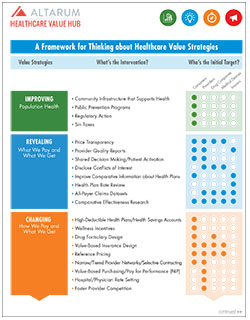Improving Value
Changing Incentives
There is agreement that transparency efforts alone are unlikely to alter the way that health care is delivered and priced to a sufficient degree. Hence, changing the incentives that providers, patients and even health plans face are key to achieving sufficient reform to get higher value.
Incentives can be broadly defined or narrowly defined. For example, the mere act of bundling together services for payment creates new incentives, even if the bundle cost is the same as the cost of the discrete services before bundling.
For purposes of our strategy framework, we intend this category to be interventions that change the financial incentives facing consumers and providers.
Some of these interventions target consumers, such as Value-Based Insurance Design (VBID) which provides clinically nuanced price signals (in the form of patient cost-sharing) about high and low value services taking into account the patient’s diagnosis. Other examples include wellness programs or the structure of ACA’s tax credit subsides which preserve the incentive to consumers to choose lower cost plans (which, granted, may not be the same thing as the high value plan).
Provider-facing incentives are the key, over and above, those facing consumers. Providers direct almost all of our health care dollars through their practice patterns, treatment recommendations and referral patterns.
Provider payment strategies, generally known as pay for performance (P4P), use evidence-based measures of quality, effectiveness, and efficiency to classify or select providers, and to determine how much they are paid.
While payers are expanding the use of contracting arrangements that have a value-based component,1 few providers face what is known as “down-side” risk, that is, significant financial risk if they fail to better manage the cost and quality of care.2
Another overarching consideration for the use of financial incentives is the role of quality measures. Experts warn that if you change financial incentives, but don’t have a robust system for measuring quality, then we're not leaving patients better off. And even though there are a plethora of quality measures, there is widespread agreement that not enough of them are outcomes based, that risk adjustment is imperfect and that consumer-facing measures do not yet engage their intended audience.
What’s clear is that the financial incentives facing providers and patients must be aligned with where we want health care delivery to go. What isn’t clear is how large a role financial incentives play in our overall solution set, compared to other approaches.
- Value-Based Insurance Design
- Reference Pricing
- Narrow Networks/Tiered-Provider Networks/Selective Contracting
- Value-Based Purchasing/Pay For Performance (P4P)
- Hospital/Physician Rate Setting
- Increase competition among providers
- Bundled Payments
- Capitation
- Global Budgets
- Determination Of Need
- Address Fraud and Abuse
Notes
1. See Catalyst for Payment Reform, National Scorecard On Payment Reform, 2014; and Medicare announcement increased use of value based payment: http://www.hhs.gov/news/press/2015pres/01/20150126a.html
2. For example, CMS proposes to delay for three years the requirement that providers in its Shared Savings accountable care program accept the risk of losses.







